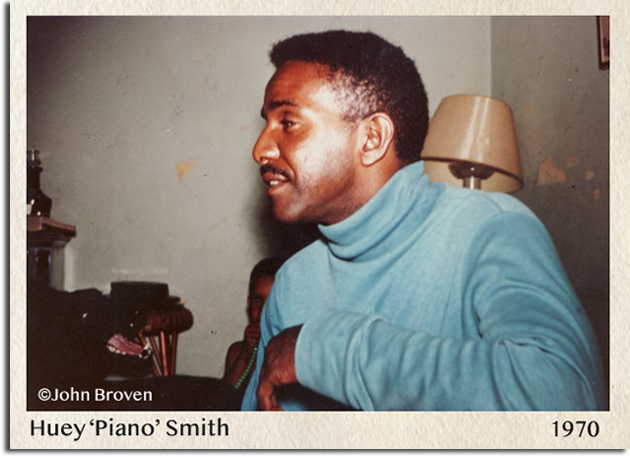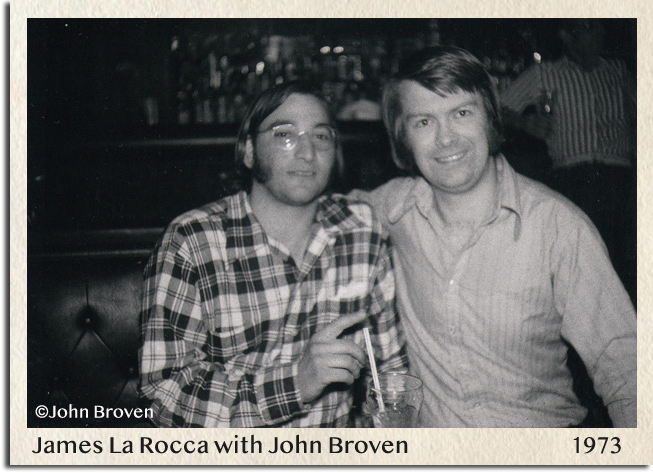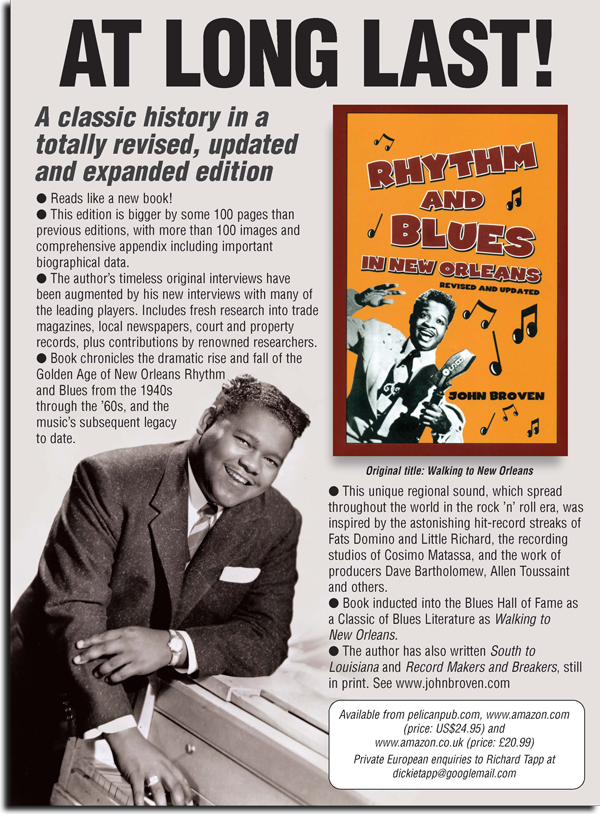

1970 New Orleans Trip:
Incredibly it's more than 50 years since I made that first trip from England to New Orleans and the Land of Dreams, in April 1970, in company with Mike Leadbitter, the visionary editor of Blues Unlimited, and Robin Gosden, of Flyright Records. Transatlantic air travel was only just opening up to the common person but already there had been notable U.S. trips by enthusiastic young BU writers such as Bruce Bastin, Mike Rowe and Leadbitter. (At the time I was unaware of the spectacular 1968 trip by Swede Jonas Bernholm.)
Our party stayed at the home of Pete and Connie La Rocca through son James, who was a BU subscriber. I did not know beforehand that Connie had owned the Frisco label in the early 1960s, with the unforgettable Danny White regional hit Kiss Tomorrow Goodbye. James, seemingly a perpetual student, had the time to escort us around the nooks and crannies of the city.
Although the classic Fats Domino-led New Orleans R&B era was over, most of the original artists were still around, decades before the Katrina diaspora. So, we were able to meet and interview Professor Longhair (living in dire circumstances pre-rediscovery), Huey Smith, Archibald and Boogie Bill Webb but were not so lucky with Earl King or Snooks Eaglin - that's all part of the research experience. We also squeezed in a trip to Camp Street to visit Cosimo's sad-looking Jazz City studio, and to interview Joe Banashak of Instant Records, where we picked up piles of 45s even though the venerable label had seen better days.
We stayed in New Orleans for only four days before heading for Baton Rouge, Cajun country (with J.D. Miller, Eddie Shuler and Floyd Soileau), Shreveport, Jackson, Mississippi (with Johnny Vincent and Lillian McMurry), Memphis, Chicago and New York.
It was this visit that inspired me to "do something" for New Orleans R&B leading to Walking to New Orleans, named of course after the Fats record.

1973 Trip:
Upon returning to England, Leadbitter asked if I had a book in mind. "What on?" I said. "Well, you've just been to New Orleans, haven't you?" he said sternly. And so I embarked on two years of research, greatly helped by an extensive interview with Mac Rebennack in London in 1972, partly with Mike. Although Mac was in Dr. John rock-star mode, all he wanted to do was to discuss little-known (at the time) hometown heroes including Walter 'Papoose' Nelson, James Booker and Prince La La. Even Smiley Lewis was something of a mystery then.
After attempting a first book draft, I became aware of my strengths and weaknesses, which was a great help when I returned to New Orleans in spring 1973 for a three-week interview trip with cassette recorder in hand. Once again I stayed at the La Rocca household, with James acting as a knowledgeable, willing chauffeur. My list of interviewees was long including Justin Adams, Dave Bartholomew, Erving Charles, Lawrence Cotton, Frank Fields, Gerri Hall, Chris Kenner, Cosimo Matassa, Deacon John Moore, Al Reed, Tommy Ridgley, Willie Tee, Earl Turbinton and Alvin 'Red' Tyler.
Through Connie La Rocca, a very popular lady among the artists, Earl King and Clarence 'Frogman' Henry actually came to the house to be interviewed. Sea-Saint studio was just opening and with co-owner Marshall Sehorn cajoling them, I was able to interview Allen Toussaint and Art Neville. There are always artists who escape the interview net, and in my case it was the always-elusive Fats and Eddie Bo (who later rebuked me for not interviewing him for the book). Just before I arrived in New Orleans, Edgar Blanchard and Cornelius Coleman had died.
It wasn't all 'work,' though. Visits were made to the Canal Street Record Store, where many local R&B and soul singles were heavily discounted, and at Jim Russell's pricey store on Magazine Street. I managed to encompass visits to the soon-to-be influential New Orleans Jazz Fest - known at the time as Louisiana Heritage Fair - under the direction of Quint Davis. Then there were shows at the Fontainebleau Motor Hotel with the Fats Domino and Dave Bartholomew bands, once with Carl Gardner's Coasters. A regular weekend hangout was Mason's Mericana motel on South Claiborne with Red Tyler, Edward Frank, Chuck Badie and Germaine Basile; there were other club visits to see Frogman Henry and Frankie Ford. Soul food was cheerfully devoured at Buster Holmes place in the Quarter.
Walking to New Orleans was released by Blues Unlimited Books (Mike Leadbitter and Simon Napier) in 1974, in effect a self-published work. Without any of us having experience in book publishing, I shudder at the thought now. However, to liberally paraphrase Dr. John, "It was the right place, right time."
I continued to conduct interviews - notably on a 1975 Los Angeles trip with key New Orleans exiles Harold Battiste, Roy Brown, Paul Gayten, Joe Jones and Earl Palmer - which have been incorporated in the third edition of the book, known now as Rhythm and Blues in New Orleans (Pelican Publishing Co., 2016). Why the change of name? In the mid-1970s, Pelican thought Walking to New Orleans was "too obscure" for American readers, although the publisher was prepared to take a chance on licensing the book for the U.S. It's still in print.
As I reflect on my interviewees, very few are still alive. Still, I am eternally grateful to everybody for telling their rich and colorful stories for posterity. What a journey it's been.
- John Broven, March 2021
PHOTOGRAPHS: (place cursor over thumbnail to enlarge)
























